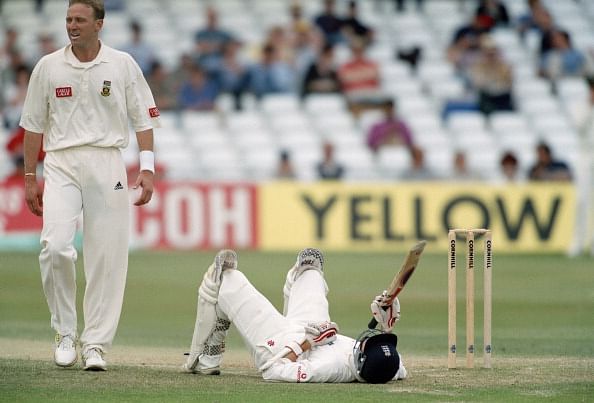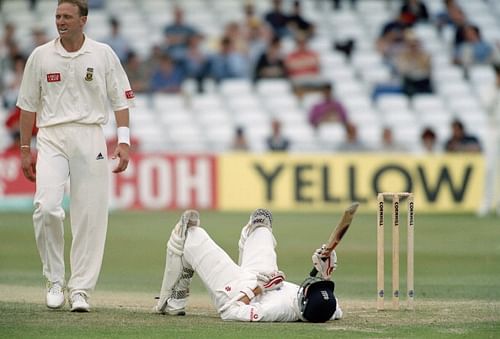
Allan Donald: When lightning struck

Allan Donald (left) floors England batsman Mike Atherton with a bouncer
Trent Bridge, Nottingham. Day 4. Third session of play. England need 247 to win and level the series. It’s a cold day, the kind of day when the sound of the willow striking the leather resounds throughout the ground. The scoreboard reads 82/1. Michael Atherton and Nasser Hussain, comrades since times unknown, have been batting quite well so far, punishing the sporadic loose deliveries. This is a key partnership, and the South Africans know it. Hansie Cronje decides to bring back the tormentor-in-chief, Allan Donald, who is at his unforgiving best. “Around the wicket”, announces umpire Steve Dunne, rather insipidly. Atherton, batting on 27, receives a stinging bouncer from Donald which climbs on to him, much like a quick jab aiming for the face. Surprised, Atherton writhes and takes his eyes away from the ball, which catches a good portion of his gloves on its way to Mark Boucher. The South Africans shout in unison, but Dunne is unmoved and so is Atherton, who has the audacity to stay put on the crease, coldly so. Donald, standing in disbelief, is visibly livid. What follows is one of the most gruelling duels in Test cricket in which Atherton bears the brunt of Donald’s fury even though the former comes out as the victor in the end. Donald hurls ferocious bouncers at Atherton, aiming for the body every time. And to rub some salt into the wound, he accompanies them with his intimidating glare and the customary pleasantries he has reserved especially for Atherton. This, ladies and gentlemen, is how the world remembers the legend of Allan Anthony Donald – the White Lightning.
Today, as he sits in the Pune Warriors India dug-out, he inspires a calm quite unlike the fear he created in the minds of the opposition players back in the nineties. Widely regarded as South Africa’s only world-class bowler when they were readmitted into the Test roster back in 1992, he carried this mantle for over half a decade till the emergence of a young Shaun Pollock, with whom he formed a lethal combination, towards the late nineties. A tall, intimidating frame steaming in towards the pitch, sending down yorkers ripping through the air or some really quick short ones angling into the body, was a sight every batsman dreaded. As Sir Geoffrey Boycott would have aptly put it, just like he did for Shane Warne, that the best way to combat Donald would be to ‘get a single down the other end and watch someone else play him’.
The physical attributes were there for all to see. Being a natural athlete, Donald never had the longest of run-ups, which invariably helped him in maintaining his high and slightly open action. He had the knack of moving the ball away from the right-handed batsmen at will, both through the air and off the pitch. When not keeping the ball in between the chest and the chin of the batsman, Donald mostly kept it fuller than most other bowlers, which is probably the reason why most of his dismissals were either getting the batsmen bowled, or LBWs.
The great Michael Holding once said that ‘when you have the capability of hurting someone, that person is not thinking about how to play the ball…he is thinking of self-preservation.’ The intention is never to inflict pain, but to induce helplessness in the batsman, and Donald’s bowling was true to this school of thought. In one torrid spell during the Sydney Test in 1997, Steve and Mark Waugh were at the receiving end of some disconcerting bounce generated by Donald. Even though they got the better of the opposition, they were really softened up by the sweet chin music they received from Donald. Steve Waugh would later go on to praise Donald as one of the best he ever faced.
Donald never had the luxury of Dale Steyn, who has the likes of Philander and Morkel supporting him. In fact, till the time Pollock broke into the scene, Donald was effectively the lone wolf on the hunt by himself. Inevitably, he was over-bowled and was plagued with injuries towards the fag end of his career, consequently retiring from Test cricket in 2001. Owing to the ban imposed on South Africa from international cricket, and with the injuries bothering him, he could never achieve that statistical greatness which his contemporaries went on to reach; but with a wicket every 47 balls, he was certainly more than effective.
He stirred up the souls, as much by his bowling as by his hot-bloodedness. In 1997, during a game at Durban, a fresh-faced, gentle-looking Rahul Dravid bore the wrath of Donald’s frustration when he tore Donald’s bowling apart. Donald would later describe this incident in his autobiography – ‘I walked right up to him, face to face, and snarled, ‘This isn’t such a f****** easy game’ and the TV cameras had me in close-up, with everyone lip-reading my words. Dravid’s eyes lit up when he saw me standing so close, and the Durban crowd absolutely loved it’. This was just his way, going no-holds-barred that is. Away from the field, Donald was just as human as anyone else. After the Nottingham Test, as Atherton writes in his book Opening Up, he and Donald buried the hatchet over a round of beer they shared in the dressing room where Atherton duly signed those ill-fated gloves and handed them over to Donald years later for his benefit year auction.
Donald is from the golden generation of fast bowlers which featured the likes of Wasim Akram, Waqar Younis, Courtney Walsh, Curtley Ambrose, Shaun Pollock and Glenn McGrath, and is definitely an equal among them, if not better. For the ones who grew up watching great fast bowling in the nineties, South African cricket’s success will always be synonymous with the image of a passionate man wearing the famous white zinc cream, which accentuated his fervid gaze, running wild with his arms aloft after knocking off the stumps and, sometimes, the toes too.